-
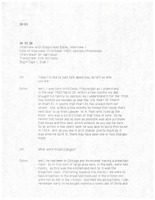 Gladys Noel Bates interviewed by Alferdteen Harrison, Transcript.
Gladys Noel Bates interviewed by Alferdteen Harrison, Transcript. Gladys Noel Bates moved to Jackson with her family in 1920 and soon after settled in the Farish Street District. She talks extensively about her entire life, including her childhood and family, attending school during desegregation, and her involvement in the Civil Rights Movement.
-
 Edward Lee interviewed by Alferdteen Harrison: “Farish Street Businessman (Owner of Edward Lee Hotel)," Transcript.
Edward Lee interviewed by Alferdteen Harrison: “Farish Street Businessman (Owner of Edward Lee Hotel)," Transcript. Edward Lee moved to the Farish Street District in 1925 and went on to own several restaurants in the area. He also booked and promoted dances and concerts for clubs and dance halls in the district. Mr. Lee talks about his education, life on a farm, family, and his youth. The transcript is heavily edited with handwritten notes.
-
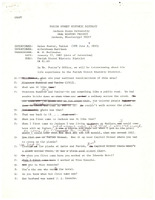 Gale Foster interviewed by Alferdteen Harrison, Transcript.
Gale Foster interviewed by Alferdteen Harrison, Transcript. Gale Foster talks about his oldest memories of visiting the Farish Street District, dating back to 1912 when Farish Street was a dirt road. Mr. Foster went on to own a tailor shop on Farish Street and he discusses his history as a tailor and his life as a business owner. The transcript is heavily edited with handwritten notes.
-
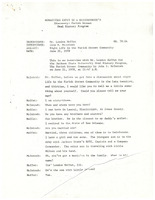 London Moffet Jr. interviewed by John R. McIntosh, Transcript.
London Moffet Jr. interviewed by John R. McIntosh, Transcript. London Moffet Jr. moved to Jackson at the age of 14 in 1931 with his parents. Mr. Moffet discusses his recollections of nightlife in the Farish Street District during his time there as a teenager. He mentions several places by name, including the Crystal Palace and Savoy. He ends by explaining the changes over time of nightlife on Farish Street.
-
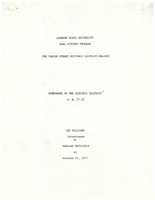 Lee Williams interviewed by Deborah McGlothin: "Homeowner in the Historic District," Transcript.
Lee Williams interviewed by Deborah McGlothin: "Homeowner in the Historic District," Transcript. Lee Williams became a homeowner in the Farish Street District in 1924. At the time of the interview he was Vice President for Administration at Jackson State. Mr. Williams discusses a variety of aspects about the district in relation to his time growing up there, including childhood activities and the different jobs he did.
-
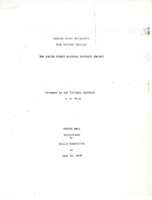 Carsie Hall interviewed by Willie Washington, Transcript.
Carsie Hall interviewed by Willie Washington, Transcript. Attorney Carsie Hall moved to Jackson in 1921 to attend Jackson College. He passed the bar exam in 1953 and operated a law firm in the Farish Street District. He talks about a case he worked with the Freedom Marchers during the Civil Rights Movement. He discusses the effect of desegregation on Black businesses and current revitalization efforts.
-
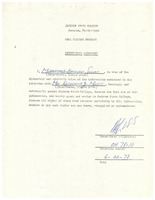 Katherine Mosley interviewed by Mohamed Bassiru Sillah, Transcript.
Katherine Mosley interviewed by Mohamed Bassiru Sillah, Transcript. Katherine Mosley moved to the Farish Street District in 1949. She recounts her time as a young person in the district, specifically the entertainment she enjoyed. Ms. Mosley also goes into detail about the decline of the district and lack of Black businesses and she gives her opinions about urban renewal on Farish Street.
-
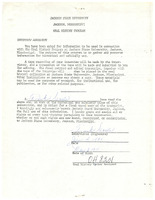 Frank Conic interviewed by Dr. Alferdteen Harrison, Transcript.
Frank Conic interviewed by Dr. Alferdteen Harrison, Transcript. Frank Conic moved to the Farish Street District in 1919. He talks about his time growing up on Farish Street and working as a barber with his father while in high school. In 1950 he opened Conic Beauty and Barber Supply and he talks about that experience as a business owner in the district. The transcript is heavily edited with handwritten notes.
-
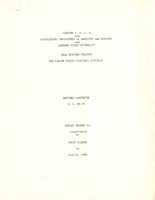 Robert Rhodes III interviewed by Doris Sirgew: "Retired Carpenter," Transcript.
Robert Rhodes III interviewed by Doris Sirgew: "Retired Carpenter," Transcript. Robert Rhodes III was born in Jackson and was a well known carpenter from doing work in the Farish Street District. He worked with his father, who owned a business in the district, until taking the business over for himself. He discusses his work during the Jim Crow Era and the difference in pay between white and Black carpenters.
-
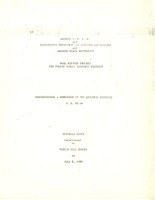 Stevella Adams interviewed by Virgie Ella Barnes: "Businesswoman & Homeowner in the Historic District," Transcript.
Stevella Adams interviewed by Virgie Ella Barnes: "Businesswoman & Homeowner in the Historic District," Transcript. Stevella Adams moved to Jackson in 1932 after graduating from college and getting married. Mrs. Adams talks about her time operating a grocery store on the corner of Monument and Blair Streets in the Farish Street District from 1952 to 1973. The store was originally owned and operated by her late father in law.
-
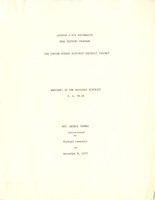 Rev. George Thomas interviewed by Michael Leveritt: "Resident in the Historic District," Transcript.
Rev. George Thomas interviewed by Michael Leveritt: "Resident in the Historic District," Transcript. Rev. George Thomas was a pastor at a church in Terry, Mississippi and also worked as a contractor and carpenter. He possessed several plans from early buildings which he built in the Farish Street District. He talks about the construction of new roads and buildings as Jackson converted from dirt roads and horses to a more metropolitan space.
-
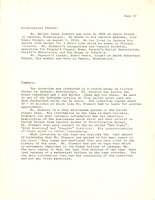 Walter Stewart interviewed by Michael Leveritt, Transcript.
Walter Stewart interviewed by Michael Leveritt, Transcript. Walter Stewart lived his entire life in the Farish Street District from 1910 and was the funeral director at People's Funeral Home in the district. He talks about the changes the area has gone through over the years and recounts several stories about people and places in the area. The transcript is edited with handwritten notes.
-
 Rev. Wendell P. Taylor interviewed by Ada Anderson, Transcript.
Rev. Wendell P. Taylor interviewed by Ada Anderson, Transcript. Rev. Wendell P. Taylor became minister at Central Methodist Church in the Farish Street District in 1963 and was retired at the time of the interview. He talks about the district being prosperous for Black businesses at that time but that a decline has taken place since businesses have left. The transcript is heavily edited with handwritten notes.
-
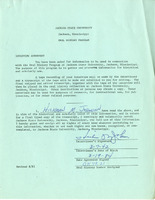 Rev. Hickman M. Johnson interviewed by Ada S. Anderson, Transcript.
Rev. Hickman M. Johnson interviewed by Ada S. Anderson, Transcript. Hickman M. Johnson came to Jackson in 1967 and had just finished his 10th year as pastor of Farish Street Baptist Church. He talks about the civil rights activist spirit that existed there in 1967. He goes on to discuss the deterioration of the district and discusses his ideas about how to revitalize the area. Transcript contains handwritten edits.
-
 Lee Williams interviewed by Eli Grayson, Transcript.
Lee Williams interviewed by Eli Grayson, Transcript. Lee Williams was born in 1900, moved to the Farish Street District in 1915, and lived on various streets for the rest of his life. He attended Smith Robertson School. In the interview, Mr. Williams recounts the different businesses, people, and schools over the years in the district. The transcript contains handwritten edits.
-
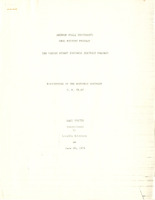 Gale Foster interviewed by Louella Robinson: "Businessman in the Historic District," Transcript.
Gale Foster interviewed by Louella Robinson: "Businessman in the Historic District," Transcript. Gale Foster moved to Jackson in 1912, attended Jackson State from 1912-1913, and opened City Barber, Beauty, and Tailor Shop in the Farish Street District in 1919. He talks about the current state of the district as well as offering advice to future Black business people, namely to get an education before starting a business.
-
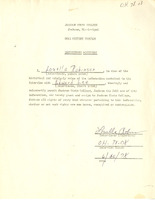 Edward Lee interviewed by Louella Robinson: "History of Black Owned Business," Transcript.
Edward Lee interviewed by Louella Robinson: "History of Black Owned Business," Transcript. Edward Lee moved to the Farish Street District in 1925 and went on to own businesses in the district including The Crystal Palace restaurant and lounge and the Edward Lee Hotel. Mr. Lee talks about his experiences with owning businesses in the district and gives advice to future Black business owners. Transcript is edited with handwritten notes.
-
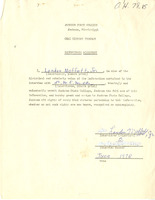 Dr. W.E. Miller interviewed by London Moffett, Jr: "Students at Smith Robertson School," Transcript.
Dr. W.E. Miller interviewed by London Moffett, Jr: "Students at Smith Robertson School," Transcript. Dr. W.E Miller was a physician and surgeon. He was born in 1903 and attended Smith Robertson School from 1908-1913. Dr. Miller talks about his time at Smith Robertson School and the community around the school, recounting the activities that were available for young people at the time. The transcript is edited with handwritten notes.
-
 Jess Brown interviewed by Catherine McMichael: "Attorney in the Historic District," Transcript.
Jess Brown interviewed by Catherine McMichael: "Attorney in the Historic District," Transcript. Attorney Jess Brown moved to the Farish Street District in 1948. He talks about his education and his legal career. He discusses his recollections of businesses on Farish Street and the effect that integration had on them. He also talks about the Civil Rights Movement and the NAACP and some of the cases he was involved with as a lawyer.
-
 Susie Noel interviewed by Dr. Alferdteen Harrison, Transcript.
Susie Noel interviewed by Dr. Alferdteen Harrison, Transcript. Susie Noel has lived in the Farish Street District since 1922. She talks about her experiences with the NAACP and the violence against Black people in the district during the Civil Rights Movement. She recounts her relationships with some of the Freedom Riders. She also talks about the different businesses and people in the district from the past.
-
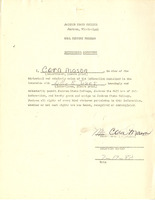 Lillie B. Jones Interviewed by Cora Mason, Transcript.
Lillie B. Jones Interviewed by Cora Mason, Transcript. Lillie B. Jones worked at the Farish Street Young Women’s Christian Association (Y.W.C.A.) from the beginning and talks about her experiences there and what the YWCA meant to the community. She also talks about her childhood and young adult days and going through the Great Depression. The transcript is edited heavily with handwritten notes.
-
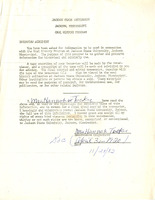 Hannah Tucker interviewed by Margaret Moore Abdullah, Transcript.
Hannah Tucker interviewed by Margaret Moore Abdullah, Transcript. Hannah Tucker moved to the Farish Street District in 1935 and opened Eat & Beat It Cafe in 1952. She talks about growing up in the district and some of the jobs she had. She also discusses some of the changes in the district over the years and her decision to soon move her business out of the district. Transcript is edited with handwritten notes.
-
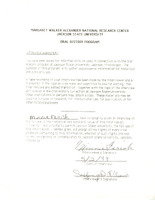 Minnie Farish interviewed by Tiffany D. Williams, Transcript.
Minnie Farish interviewed by Tiffany D. Williams, Transcript. Minnie Farish was born on Farish Street and lived her life there. Ms. Farish talks about her childhood on Farish Street and her time at Smith Robertson School and Lanier High School. She recounts the homes and businesses on Farish Street and talks extensively about her family. She also talks about what it was like living in the Jim Crow Era.
-
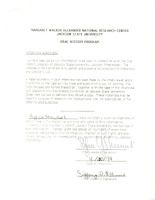 Sylvia Stewart interviewed by Tiffany D. Williams, Transcript.
Sylvia Stewart interviewed by Tiffany D. Williams, Transcript. Sylvia Stewart was born in the Farish Street District. Ms. Stewart talks about her experiences growing up in the district during the era of Jim Crow segregation; the business her grandfather and father owned; and her experiences with racism. The transcript is edited with handwritten notes.
-
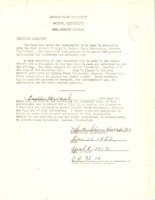 Esther Solomon Howard interviewed by Alferdteen Harrison, Transcript.
Esther Solomon Howard interviewed by Alferdteen Harrison, Transcript. Esther Solomon Howard was born in the Farish Street District in 1915. Ms. Howard talks about her childhood in the Farish Street District, including attending Smith Robertson School, Central Church, and the Young Women’s Christian Association (Y.W.C.A.). She also talks extensively about her husband. The transcript is edited with handwritten notes.
 Gladys Noel Bates interviewed by Alferdteen Harrison, Transcript. Gladys Noel Bates moved to Jackson with her family in 1920 and soon after settled in the Farish Street District. She talks extensively about her entire life, including her childhood and family, attending school during desegregation, and her involvement in the Civil Rights Movement.
Gladys Noel Bates interviewed by Alferdteen Harrison, Transcript. Gladys Noel Bates moved to Jackson with her family in 1920 and soon after settled in the Farish Street District. She talks extensively about her entire life, including her childhood and family, attending school during desegregation, and her involvement in the Civil Rights Movement. Edward Lee interviewed by Alferdteen Harrison: “Farish Street Businessman (Owner of Edward Lee Hotel)," Transcript. Edward Lee moved to the Farish Street District in 1925 and went on to own several restaurants in the area. He also booked and promoted dances and concerts for clubs and dance halls in the district. Mr. Lee talks about his education, life on a farm, family, and his youth. The transcript is heavily edited with handwritten notes.
Edward Lee interviewed by Alferdteen Harrison: “Farish Street Businessman (Owner of Edward Lee Hotel)," Transcript. Edward Lee moved to the Farish Street District in 1925 and went on to own several restaurants in the area. He also booked and promoted dances and concerts for clubs and dance halls in the district. Mr. Lee talks about his education, life on a farm, family, and his youth. The transcript is heavily edited with handwritten notes. Gale Foster interviewed by Alferdteen Harrison, Transcript. Gale Foster talks about his oldest memories of visiting the Farish Street District, dating back to 1912 when Farish Street was a dirt road. Mr. Foster went on to own a tailor shop on Farish Street and he discusses his history as a tailor and his life as a business owner. The transcript is heavily edited with handwritten notes.
Gale Foster interviewed by Alferdteen Harrison, Transcript. Gale Foster talks about his oldest memories of visiting the Farish Street District, dating back to 1912 when Farish Street was a dirt road. Mr. Foster went on to own a tailor shop on Farish Street and he discusses his history as a tailor and his life as a business owner. The transcript is heavily edited with handwritten notes. London Moffet Jr. interviewed by John R. McIntosh, Transcript. London Moffet Jr. moved to Jackson at the age of 14 in 1931 with his parents. Mr. Moffet discusses his recollections of nightlife in the Farish Street District during his time there as a teenager. He mentions several places by name, including the Crystal Palace and Savoy. He ends by explaining the changes over time of nightlife on Farish Street.
London Moffet Jr. interviewed by John R. McIntosh, Transcript. London Moffet Jr. moved to Jackson at the age of 14 in 1931 with his parents. Mr. Moffet discusses his recollections of nightlife in the Farish Street District during his time there as a teenager. He mentions several places by name, including the Crystal Palace and Savoy. He ends by explaining the changes over time of nightlife on Farish Street. Lee Williams interviewed by Deborah McGlothin: "Homeowner in the Historic District," Transcript. Lee Williams became a homeowner in the Farish Street District in 1924. At the time of the interview he was Vice President for Administration at Jackson State. Mr. Williams discusses a variety of aspects about the district in relation to his time growing up there, including childhood activities and the different jobs he did.
Lee Williams interviewed by Deborah McGlothin: "Homeowner in the Historic District," Transcript. Lee Williams became a homeowner in the Farish Street District in 1924. At the time of the interview he was Vice President for Administration at Jackson State. Mr. Williams discusses a variety of aspects about the district in relation to his time growing up there, including childhood activities and the different jobs he did. Carsie Hall interviewed by Willie Washington, Transcript. Attorney Carsie Hall moved to Jackson in 1921 to attend Jackson College. He passed the bar exam in 1953 and operated a law firm in the Farish Street District. He talks about a case he worked with the Freedom Marchers during the Civil Rights Movement. He discusses the effect of desegregation on Black businesses and current revitalization efforts.
Carsie Hall interviewed by Willie Washington, Transcript. Attorney Carsie Hall moved to Jackson in 1921 to attend Jackson College. He passed the bar exam in 1953 and operated a law firm in the Farish Street District. He talks about a case he worked with the Freedom Marchers during the Civil Rights Movement. He discusses the effect of desegregation on Black businesses and current revitalization efforts. Katherine Mosley interviewed by Mohamed Bassiru Sillah, Transcript. Katherine Mosley moved to the Farish Street District in 1949. She recounts her time as a young person in the district, specifically the entertainment she enjoyed. Ms. Mosley also goes into detail about the decline of the district and lack of Black businesses and she gives her opinions about urban renewal on Farish Street.
Katherine Mosley interviewed by Mohamed Bassiru Sillah, Transcript. Katherine Mosley moved to the Farish Street District in 1949. She recounts her time as a young person in the district, specifically the entertainment she enjoyed. Ms. Mosley also goes into detail about the decline of the district and lack of Black businesses and she gives her opinions about urban renewal on Farish Street. Frank Conic interviewed by Dr. Alferdteen Harrison, Transcript. Frank Conic moved to the Farish Street District in 1919. He talks about his time growing up on Farish Street and working as a barber with his father while in high school. In 1950 he opened Conic Beauty and Barber Supply and he talks about that experience as a business owner in the district. The transcript is heavily edited with handwritten notes.
Frank Conic interviewed by Dr. Alferdteen Harrison, Transcript. Frank Conic moved to the Farish Street District in 1919. He talks about his time growing up on Farish Street and working as a barber with his father while in high school. In 1950 he opened Conic Beauty and Barber Supply and he talks about that experience as a business owner in the district. The transcript is heavily edited with handwritten notes. Robert Rhodes III interviewed by Doris Sirgew: "Retired Carpenter," Transcript. Robert Rhodes III was born in Jackson and was a well known carpenter from doing work in the Farish Street District. He worked with his father, who owned a business in the district, until taking the business over for himself. He discusses his work during the Jim Crow Era and the difference in pay between white and Black carpenters.
Robert Rhodes III interviewed by Doris Sirgew: "Retired Carpenter," Transcript. Robert Rhodes III was born in Jackson and was a well known carpenter from doing work in the Farish Street District. He worked with his father, who owned a business in the district, until taking the business over for himself. He discusses his work during the Jim Crow Era and the difference in pay between white and Black carpenters. Stevella Adams interviewed by Virgie Ella Barnes: "Businesswoman & Homeowner in the Historic District," Transcript. Stevella Adams moved to Jackson in 1932 after graduating from college and getting married. Mrs. Adams talks about her time operating a grocery store on the corner of Monument and Blair Streets in the Farish Street District from 1952 to 1973. The store was originally owned and operated by her late father in law.
Stevella Adams interviewed by Virgie Ella Barnes: "Businesswoman & Homeowner in the Historic District," Transcript. Stevella Adams moved to Jackson in 1932 after graduating from college and getting married. Mrs. Adams talks about her time operating a grocery store on the corner of Monument and Blair Streets in the Farish Street District from 1952 to 1973. The store was originally owned and operated by her late father in law. Rev. George Thomas interviewed by Michael Leveritt: "Resident in the Historic District," Transcript. Rev. George Thomas was a pastor at a church in Terry, Mississippi and also worked as a contractor and carpenter. He possessed several plans from early buildings which he built in the Farish Street District. He talks about the construction of new roads and buildings as Jackson converted from dirt roads and horses to a more metropolitan space.
Rev. George Thomas interviewed by Michael Leveritt: "Resident in the Historic District," Transcript. Rev. George Thomas was a pastor at a church in Terry, Mississippi and also worked as a contractor and carpenter. He possessed several plans from early buildings which he built in the Farish Street District. He talks about the construction of new roads and buildings as Jackson converted from dirt roads and horses to a more metropolitan space. Walter Stewart interviewed by Michael Leveritt, Transcript. Walter Stewart lived his entire life in the Farish Street District from 1910 and was the funeral director at People's Funeral Home in the district. He talks about the changes the area has gone through over the years and recounts several stories about people and places in the area. The transcript is edited with handwritten notes.
Walter Stewart interviewed by Michael Leveritt, Transcript. Walter Stewart lived his entire life in the Farish Street District from 1910 and was the funeral director at People's Funeral Home in the district. He talks about the changes the area has gone through over the years and recounts several stories about people and places in the area. The transcript is edited with handwritten notes. Rev. Wendell P. Taylor interviewed by Ada Anderson, Transcript. Rev. Wendell P. Taylor became minister at Central Methodist Church in the Farish Street District in 1963 and was retired at the time of the interview. He talks about the district being prosperous for Black businesses at that time but that a decline has taken place since businesses have left. The transcript is heavily edited with handwritten notes.
Rev. Wendell P. Taylor interviewed by Ada Anderson, Transcript. Rev. Wendell P. Taylor became minister at Central Methodist Church in the Farish Street District in 1963 and was retired at the time of the interview. He talks about the district being prosperous for Black businesses at that time but that a decline has taken place since businesses have left. The transcript is heavily edited with handwritten notes. Rev. Hickman M. Johnson interviewed by Ada S. Anderson, Transcript. Hickman M. Johnson came to Jackson in 1967 and had just finished his 10th year as pastor of Farish Street Baptist Church. He talks about the civil rights activist spirit that existed there in 1967. He goes on to discuss the deterioration of the district and discusses his ideas about how to revitalize the area. Transcript contains handwritten edits.
Rev. Hickman M. Johnson interviewed by Ada S. Anderson, Transcript. Hickman M. Johnson came to Jackson in 1967 and had just finished his 10th year as pastor of Farish Street Baptist Church. He talks about the civil rights activist spirit that existed there in 1967. He goes on to discuss the deterioration of the district and discusses his ideas about how to revitalize the area. Transcript contains handwritten edits. Lee Williams interviewed by Eli Grayson, Transcript. Lee Williams was born in 1900, moved to the Farish Street District in 1915, and lived on various streets for the rest of his life. He attended Smith Robertson School. In the interview, Mr. Williams recounts the different businesses, people, and schools over the years in the district. The transcript contains handwritten edits.
Lee Williams interviewed by Eli Grayson, Transcript. Lee Williams was born in 1900, moved to the Farish Street District in 1915, and lived on various streets for the rest of his life. He attended Smith Robertson School. In the interview, Mr. Williams recounts the different businesses, people, and schools over the years in the district. The transcript contains handwritten edits. Gale Foster interviewed by Louella Robinson: "Businessman in the Historic District," Transcript. Gale Foster moved to Jackson in 1912, attended Jackson State from 1912-1913, and opened City Barber, Beauty, and Tailor Shop in the Farish Street District in 1919. He talks about the current state of the district as well as offering advice to future Black business people, namely to get an education before starting a business.
Gale Foster interviewed by Louella Robinson: "Businessman in the Historic District," Transcript. Gale Foster moved to Jackson in 1912, attended Jackson State from 1912-1913, and opened City Barber, Beauty, and Tailor Shop in the Farish Street District in 1919. He talks about the current state of the district as well as offering advice to future Black business people, namely to get an education before starting a business. Edward Lee interviewed by Louella Robinson: "History of Black Owned Business," Transcript. Edward Lee moved to the Farish Street District in 1925 and went on to own businesses in the district including The Crystal Palace restaurant and lounge and the Edward Lee Hotel. Mr. Lee talks about his experiences with owning businesses in the district and gives advice to future Black business owners. Transcript is edited with handwritten notes.
Edward Lee interviewed by Louella Robinson: "History of Black Owned Business," Transcript. Edward Lee moved to the Farish Street District in 1925 and went on to own businesses in the district including The Crystal Palace restaurant and lounge and the Edward Lee Hotel. Mr. Lee talks about his experiences with owning businesses in the district and gives advice to future Black business owners. Transcript is edited with handwritten notes. Dr. W.E. Miller interviewed by London Moffett, Jr: "Students at Smith Robertson School," Transcript. Dr. W.E Miller was a physician and surgeon. He was born in 1903 and attended Smith Robertson School from 1908-1913. Dr. Miller talks about his time at Smith Robertson School and the community around the school, recounting the activities that were available for young people at the time. The transcript is edited with handwritten notes.
Dr. W.E. Miller interviewed by London Moffett, Jr: "Students at Smith Robertson School," Transcript. Dr. W.E Miller was a physician and surgeon. He was born in 1903 and attended Smith Robertson School from 1908-1913. Dr. Miller talks about his time at Smith Robertson School and the community around the school, recounting the activities that were available for young people at the time. The transcript is edited with handwritten notes. Jess Brown interviewed by Catherine McMichael: "Attorney in the Historic District," Transcript. Attorney Jess Brown moved to the Farish Street District in 1948. He talks about his education and his legal career. He discusses his recollections of businesses on Farish Street and the effect that integration had on them. He also talks about the Civil Rights Movement and the NAACP and some of the cases he was involved with as a lawyer.
Jess Brown interviewed by Catherine McMichael: "Attorney in the Historic District," Transcript. Attorney Jess Brown moved to the Farish Street District in 1948. He talks about his education and his legal career. He discusses his recollections of businesses on Farish Street and the effect that integration had on them. He also talks about the Civil Rights Movement and the NAACP and some of the cases he was involved with as a lawyer. Susie Noel interviewed by Dr. Alferdteen Harrison, Transcript. Susie Noel has lived in the Farish Street District since 1922. She talks about her experiences with the NAACP and the violence against Black people in the district during the Civil Rights Movement. She recounts her relationships with some of the Freedom Riders. She also talks about the different businesses and people in the district from the past.
Susie Noel interviewed by Dr. Alferdteen Harrison, Transcript. Susie Noel has lived in the Farish Street District since 1922. She talks about her experiences with the NAACP and the violence against Black people in the district during the Civil Rights Movement. She recounts her relationships with some of the Freedom Riders. She also talks about the different businesses and people in the district from the past. Lillie B. Jones Interviewed by Cora Mason, Transcript. Lillie B. Jones worked at the Farish Street Young Women’s Christian Association (Y.W.C.A.) from the beginning and talks about her experiences there and what the YWCA meant to the community. She also talks about her childhood and young adult days and going through the Great Depression. The transcript is edited heavily with handwritten notes.
Lillie B. Jones Interviewed by Cora Mason, Transcript. Lillie B. Jones worked at the Farish Street Young Women’s Christian Association (Y.W.C.A.) from the beginning and talks about her experiences there and what the YWCA meant to the community. She also talks about her childhood and young adult days and going through the Great Depression. The transcript is edited heavily with handwritten notes. Hannah Tucker interviewed by Margaret Moore Abdullah, Transcript. Hannah Tucker moved to the Farish Street District in 1935 and opened Eat & Beat It Cafe in 1952. She talks about growing up in the district and some of the jobs she had. She also discusses some of the changes in the district over the years and her decision to soon move her business out of the district. Transcript is edited with handwritten notes.
Hannah Tucker interviewed by Margaret Moore Abdullah, Transcript. Hannah Tucker moved to the Farish Street District in 1935 and opened Eat & Beat It Cafe in 1952. She talks about growing up in the district and some of the jobs she had. She also discusses some of the changes in the district over the years and her decision to soon move her business out of the district. Transcript is edited with handwritten notes. Minnie Farish interviewed by Tiffany D. Williams, Transcript. Minnie Farish was born on Farish Street and lived her life there. Ms. Farish talks about her childhood on Farish Street and her time at Smith Robertson School and Lanier High School. She recounts the homes and businesses on Farish Street and talks extensively about her family. She also talks about what it was like living in the Jim Crow Era.
Minnie Farish interviewed by Tiffany D. Williams, Transcript. Minnie Farish was born on Farish Street and lived her life there. Ms. Farish talks about her childhood on Farish Street and her time at Smith Robertson School and Lanier High School. She recounts the homes and businesses on Farish Street and talks extensively about her family. She also talks about what it was like living in the Jim Crow Era. Sylvia Stewart interviewed by Tiffany D. Williams, Transcript. Sylvia Stewart was born in the Farish Street District. Ms. Stewart talks about her experiences growing up in the district during the era of Jim Crow segregation; the business her grandfather and father owned; and her experiences with racism. The transcript is edited with handwritten notes.
Sylvia Stewart interviewed by Tiffany D. Williams, Transcript. Sylvia Stewart was born in the Farish Street District. Ms. Stewart talks about her experiences growing up in the district during the era of Jim Crow segregation; the business her grandfather and father owned; and her experiences with racism. The transcript is edited with handwritten notes. Esther Solomon Howard interviewed by Alferdteen Harrison, Transcript. Esther Solomon Howard was born in the Farish Street District in 1915. Ms. Howard talks about her childhood in the Farish Street District, including attending Smith Robertson School, Central Church, and the Young Women’s Christian Association (Y.W.C.A.). She also talks extensively about her husband. The transcript is edited with handwritten notes.
Esther Solomon Howard interviewed by Alferdteen Harrison, Transcript. Esther Solomon Howard was born in the Farish Street District in 1915. Ms. Howard talks about her childhood in the Farish Street District, including attending Smith Robertson School, Central Church, and the Young Women’s Christian Association (Y.W.C.A.). She also talks extensively about her husband. The transcript is edited with handwritten notes.